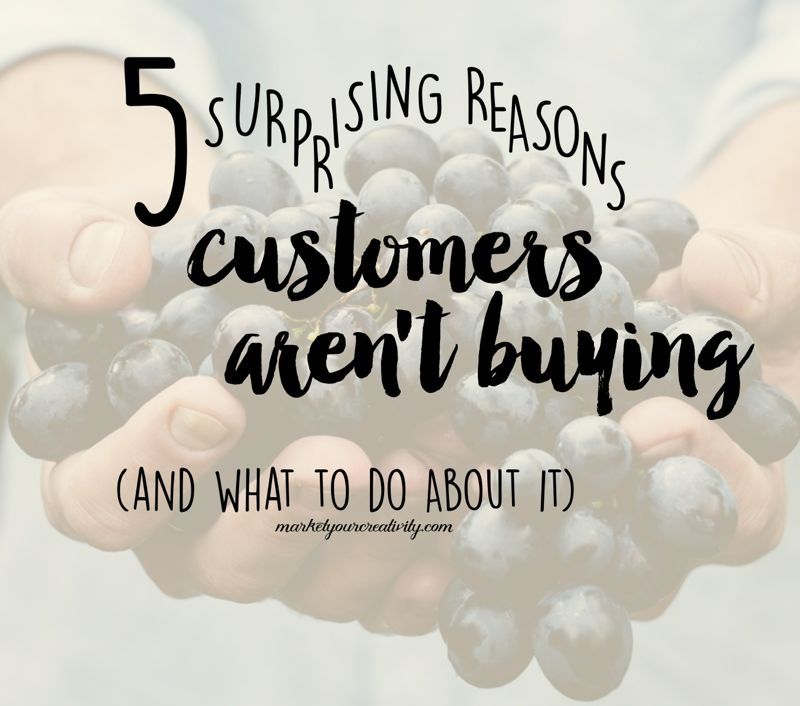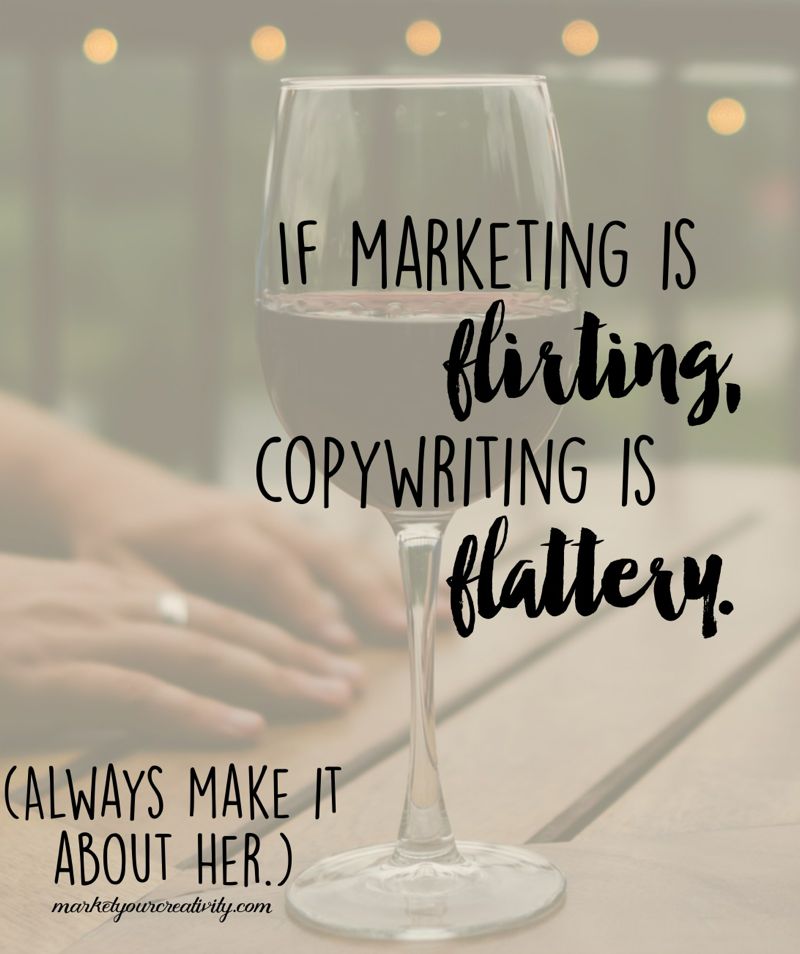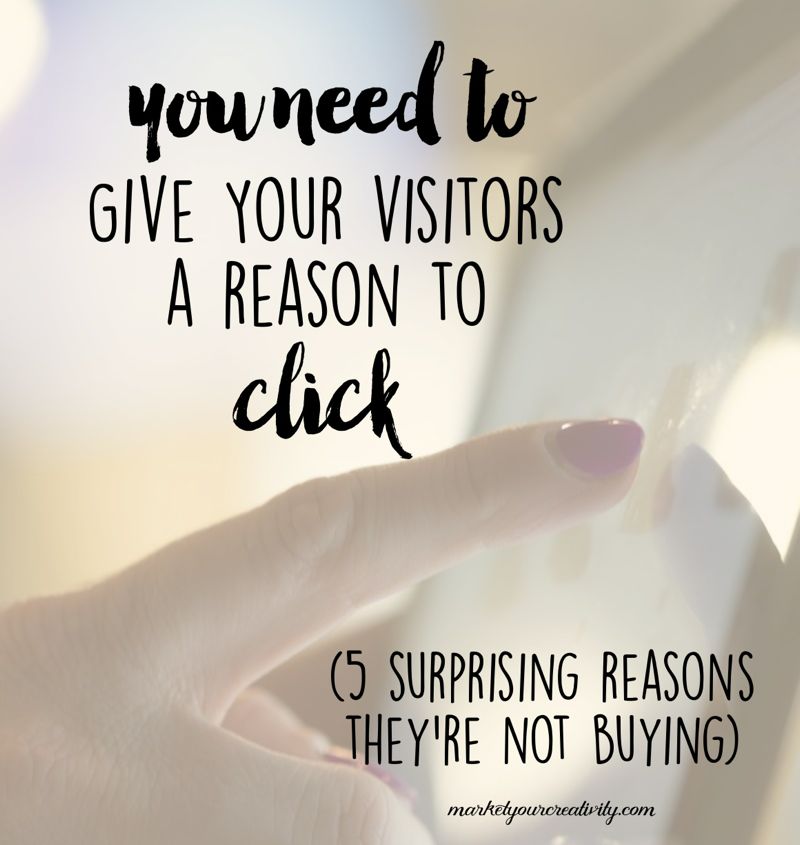Welcome here, lovely creative! Today I’m sharing five surprising reasons customers aren’t buying from you (and what to do about it).
1. There’s no motivation for them to buy.
Think about how long you think about some purchases. Have you ever …
- Browsed an Etsy shop for weeks, and though you love and adore the product, you still haven’t made the decision to buy?
- Daydreamed of an expensive addition for your home, but talk yourself out of making the investment over and over again?
- Added a much-needed book to your wish list, then left it sit there for months?
Why do we do this? It’s simply human inertia. From Wikipedia,
“Inertia is the resistance of any physical object to any change in its state of motion, including changes to its speed and direction. It is the tendency of objects to keep moving in a straight line at constant velocity.”
Have you ever made a purchase somewhere, and then spent the rest of the day buying everything you’ve been wanting/needing for months? As if you “broke the seal” on your spending hiatus? We often call it “splurging,” but what’s really happening is that you overcame your resistance to spending, and moved into a direction of buying.
When you leave off a reason to “buy now”, you offer no motivation for them to buy at all. This is why the retail and service industries have time-sensitive sales, promotional offers and deadlines.
2. Your product descriptions are all about you.
Ever go on a date with a person who could not stop talking about themselves? And you can’t wait for the exchange to be over so you can get on with your life and let them get back to being in love … with themselves?
Well, if marketing is flirting, copywriting is flattery. You’re trying to show the customer that this product is for them, and they’re the only one on your mind. Pretend you’re shopping for a new blanket, and check out the following product description examples (from my best-selling e-program, Shop Fundamentals) …
Your listing could say:
(1.) “I created this afghan using pure alpaca yarn. I carefully knitted each garter stitch. It’s lovingly packed by me, and then delivered to you, with a note of gratitude.”
Or, it could say:
(2.) “This warm, luxurious afghan was created from the best-quality, softest yarn that money can buy. The neutral colors will enhance any living room; it will look gorgeous draped over your favorite chair. This blanket is waiting to be well-loved. Your family will fight over who gets to use it!”
As a shopper, which of the above paragraphs appeal to you?
Example 1 is written by the seller, for the seller. Whether you realize it or not, when you write a listing like this, you ask the customer to envision you knitting away in your home. When I read example number 1, I picture my grandmother. I remember her sitting by a fireplace crocheting an afghan, and I really loved her afghans, but that’s because they came from her. I don’t necessarily want an afghan made by a stranger’s grandma in a home I’ve never seen before.
Example 2 is written by the seller, for the customer. I don’t need to know what your living room looks like in order to make you think of it. I certainly don’t know what your favorite chair looks like, but I bet you could easily picture it with a pretty knitted afghan draped over it!
Moreover, I have a large family that loves to get cozy and watch movies in the living room. We keep a stock of pillows and blankets for this special time that we enjoy so much. If I was interested in the knitted afghan above, I would read example 2 and know for sure my whole family was going to fight for that blanket! Therefore, I’d buy two.
In the first example, you pictured the maker’s house. In the second example, you pictured your own home in which this afghan becomes a favorite treasure. Be very careful where you take your customer with your product descriptions. You want to join the conversation in their mind (where they’re thinking of themselves), NOT interrupt their thoughts with details and descriptions about what you’re doing somewhere else.
3. You’re losing them with the shop talk.
I was recently hired by an amazing photographer who could not understand why nobody was buying her prints. She wanted to know what she needed to improve in order to start turning a profit on her failing online business.
I always approach a client session as if I’m an interested buyer who stumbled across the seller on my own accord. At first glance, her work was beautiful and her talent was apparent. The photographs were selling themselves!
I clicked on the listing I was most interested in purchasing, and that’s where she lost me. There were a lot of options written in a language I did not understand. The first paragraph of the listing launched into resolution and pixel talk (a photographer’s language). If you wanted to buy her print, you had to pick out paper textures and quality; she listed the actual names of the paper (a printer’s language).
Well, I’m not a photographer. Or a printer. And neither are her potential customers!
It’s a common seller mistake to create more options in an effort to obtain more customers, but you’ll actually lose sales by doing so. Remember human inertia? All those options are actually giving your customers a reason not to buy. It’s too much fuss.
A customer comes to you because you’re the expert. My client was the trusted photographer and printer, yet if you read her listings, the only people who could possibly understand them were other photographers and printers (and they’re not interested).
You may think your customers need options, but they actually want to trust your expertise. Be a good expert, and decide the resolution, best size and whether it should be glossy or mat. Leave the technical stuff somewhere towards the bottom in the listing, put the sizing we can all understand up top (5×7, 8×10, etc.), and let the customer trust and enjoy your hard-earned knowledge.
4. You’re not giving them a visual.
Visuals are extremely important these days, especially with the rise of social media platforms, such as Pinterest and Instagram. When I’m talking product photography with my clients, I have a strict guideline that the main listing picture should sell the product all by itself.
Have you ever spotted something on Pinterest and thought, “I want that! I don’t care how much it costs!” That’s a well-executed product photo and what you’re aiming for every time you create an image to represent your brand.
I keep inspiration boards and wish lists on my Pinterest account so that I’m always learning more about what captures and compels a user to click. I then adjust my photography or graphics accordingly.
5. Your customer hasn’t tried it on yet.
I love this one, and I think you will too. Yes, I know we’re talking online business, and there’s no way the customer can actually try on the product before they buy. But, you’re forgetting one important factor …
The customer always tries the product on in their mind first.
Right? Just think about it for a second. When you see a product, even if it’s physically in front of you in an actual store, you first think: How would I look in that? And you try it on in your mind’s eye. If you bump into a unique lamp or see a gorgeous painting, you think: Where would I put that in my home? And then you imagine it there!
Therefore, you need to use your product description to help the customer “try it on.”
If I asked you to imagine how fresh you would look wearing one of my big, chunky turquoise bracelets with a white t-shirt and your favorite pair of jeans … What do you do? You picture yourself wearing a chunky turquoise bracelet, a white t-shirt and your favorite pair of jeans.
 You took my product and tried it on in your mind, and why? Simply because I offered you the visual. Take that advice and try it on for size!
You took my product and tried it on in your mind, and why? Simply because I offered you the visual. Take that advice and try it on for size!
Thanks for reading, and if you loved this lesson, please be sure to check out The Luminaries Club where I’m currently teaching a 9-month creative business course full of marketing strategies and techniques just like these (only bettah)!
Until next time and all the best,





loved number2! I am always thinking about making it personal but it is more than that
Thanks, Susan – glad you found it useful!
Best advice I’ve heard in a very long time. I can go an apply these tips today. Thanks Lisa!.
Thank you, Kelly. Your comment made my day 🙂
Thank you so much for this post Lisa! I love your last paragraph about trying it on, it is so true! It’s going to be very useful for my next listings, I’m aiming at 100 items in stock and then go back and re-work the ones who didn’t made it to the spotlight.
Thank you, Maxime! Appreciate the comment <3
Wonderful! I’m heading over to my shop now to tweak those listing descriptions! Thanks Lisa! <3
— Brittany Witt
Get it, girl! Thanks for the note, Brittany 🙂
Wow – what a powerful post, Lisa! And so true! I loved your point that product descriptions should be written with the BUYER in mind, not the seller. This article should be shared with every person who sells products online. I’m off to share it with my followers now!
Keep up the great articles here. You are an inspiration to us all.
Why thank you, Julie! Glad you found it useful <3
Thank you so much! I get a lot of views to my shop but not a lot of people buying. I will need to work this week on tweaking my descriptions of my listing. Great suggestions!
Lori
You always have the best tips! Thanks, I will keep this bookmarked 🙂
So much great information! I am just getting back into my crafting and looking to sell some items (if I can let them go or haven’t given them away) and this is all helpful information I can use. Thank you.
What a great way to look at description that I could not see as a seller.